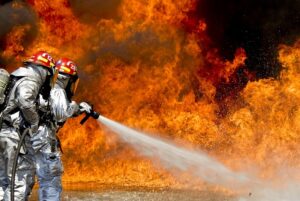
7 Crucial Ways Fire Doors Enhance Fire Safety in Ireland
Fire safety is of paramount importance, serving as a critical component in safeguarding lives and property from the devastating effects of fire. In Ireland, where the architectural tapestry ranges from historic buildings to modern edifices, the emphasis on fire safety is both a legal and moral obligation. Passive fire protection plays a crucial role in this regard, functioning silently in the background to limit the spread of fire and smoke, thus providing occupants with valuable time to evacuate safely. Among the various elements of passive fire protection, fire doors stand out due to their unique blend of functionality and necessity.
Fire doors are engineered to withstand the spread of fire within a building, effectively compartmentalising fire outbreaks and slowing down the spread of flame and smoke. Their key functions include the ability to automatically close in the event of a fire, acting as a barrier to fire and smoke, while also permitting safe egress for building occupants.
Additionally, fire doors help preserve the structural integrity of a building, providing emergency services with more time to carry out firefighting operations. Understanding the critical roles and responsibilities of fire doors highlights their indispensable contribution to comprehensive fire safety strategies in Ireland.
It is also worth bearing in mind that Fire Doors are only one element of Passive Fire Protection.
1. Fire Doors Prevent the Spread of Flames and Smoke
Fire doors are ingeniously designed to contain flames and drastically limit the spread of smoke, which is crucial for the safety and survivability of building occupants in the event of a fire. These specialised doors achieve this through the use of intumescent seals, which expand when exposed to high temperatures, sealing off the gaps between the door and its frame.
This expansion blocks smoke and flames from passing through, thereby maintaining the compartmentalisation of the fire. The primary importance of this containment lies in protecting escape routes, ensuring they remain passable and safe for longer periods, which is vital for the evacuation process.
Furthermore, by impeding the movement of smoke, fire doors significantly reduce the risks associated with smoke inhalation – the leading cause of death and injury in fires. Smoke carries toxic gases such as carbon monoxide, which can incapacitate individuals long before flames reach them, making the preservation of clean airways crucial for escape and rescue efforts.
Through these mechanisms, fire doors serve not just as physical barriers, but as critical components of a building’s fire safety strategy, safeguarding lives by providing precious extra minutes for evacuation and response.
2. Fire Doors Reduce Oxygen Supply to the Fire
One of the more subtle, yet vital roles of fire doors is their capability to stunt a fire’s growth by restricting its oxygen supply. A fire thrives on oxygen; it is one of the three elements a fire needs to sustain itself, alongside fuel and heat.
When a fire door closes, either automatically in response to fire alarms or manually by occupants, it seals off a room or compartment within a building. This action considerably limits the influx of fresh air, which is otherwise drawn into the fire, feeding its intensity and enabling it to spread.
By containing the fire in a defined area, the oxygen within this space is quickly consumed by the fire, and without a fresh supply, the fire’s rate of spread is significantly reduced. This reduction not only slows down the fire’s progression but, in certain situations, can lead to the fire being suffocated or extinguished due to a lack of oxygen.
This capability highlights the importance of correctly installed and maintained fire doors in creating compartments within buildings that can serve as both a sanctuary for occupants and a barrier to the spread of fire.
3. Structural Integrity and Stability Provided by Fire Doors
Fire doors play a pivotal role in maintaining the structural integrity of buildings during fires, safeguarding them from potential collapse. The intense heat generated by a fire can weaken the steel and iron components that support a building, leading to structural failure. By containing the fire to specific compartments, fire doors limit the exposure of these critical structural elements to high temperatures, thereby reducing the risk of a fire-induced collapse.
The integration of fire doors into a building’s design is a testament to the foresight of fire safety engineering, focusing not only on the immediate safety of occupants but also on the longevity and resilience of the structure itself. This containment strategy ensures that load-bearing walls and floors are shielded from the intense heat, preserving their strength and stability. Consequently, fire doors provide emergency services with a safer environment to conduct rescue operations, significantly increasing the chances of saving both lives and property.
Furthermore, the role of fire doors extends beyond the active duration of a fire. In the aftermath, the preservation of structural integrity facilitated by fire doors can expedite recovery efforts, allowing for quicker reoccupation and lessening the economic impact of the fire. This dual function of protecting during and after a fire underlines the essential contribution of fire doors to both safety and sustainability in building design.
Through their capability to compartmentalise fire, control its spread, and significantly reduce its thermal impact on structural components, fire doors emerge as critical allies in the mission to prevent building collapse during fires. Their presence amplifies a building’s resilience against the devastating effects of fire, highlighting their indispensable role in the architectural fabric of Ireland.
4. Role of Fire Doors in Securing Evacuation Paths for Occupants
Fire doors are integral to the architecture of safety, playing a crucial role in securing evacuation paths for building occupants during emergencies. Their design is central to the concept of compartmentalisation, which not only contains the fire but also safeguards the routes used for evacuation, ensuring they remain free from smoke and flames. This is particularly important in multi-storey buildings, where the options for escape are limited and the density of occupants can be high.
The relationship between fire doors and emergency evacuation procedures is symbiotic. Fire doors are strategically placed along escape routes, acting as a retardant to fire and smoke, while guiding occupants to safety. These doors are often fitted with panic hardware to facilitate quick and easy opening, allowing people to exit rapidly without compromising the door’s ability to close automatically and resume its protective role.
In the event of a fire, the function of fire doors in preserving the integrity of escape routes becomes even more critical. They provide a clear and protected path to emergency exits and assembly points, a necessity underscored in emergency evacuation drills and plans. This underscores not just the physical presence of fire doors, but also the importance of regular maintenance and inspection to ensure their proper function. The symbiosis between fire doors and evacuation strategies underscores a fundamental truth in fire safety: the design of buildings, when thoughtfully executed, can be a powerful protector of lives.
5. Limiting Property Damage in the Event of a Fire
In addition to safeguarding lives, fire doors play a crucial role in minimizing property damage during a fire. By compartmentalising the blaze, fire doors prevent the spread of fire and smoke to other parts of a building, thereby limiting the area affected. This containment reduces the extent of damage to the building’s structure and interiors, including furniture, equipment, and other valuable assets. Consequently, areas beyond the fire-impacted compartment often remain untouched or only minimally affected, which significantly lowers repair and clean-up costs.
The cost-effectiveness of fire doors extends beyond their role in damage limitation. By reducing the extent of destruction, fire doors decrease the need for extensive repairs and replacements post-fire, leading to considerable financial savings. Furthermore, the installation of fire doors can result in lower insurance premiums, as they are recognized by insurance companies as vital fire safety measures that reduce risk. The initial investment in high-quality fire doors thus pays dividends not only in terms of enhancing safety and preserving property but also in financial savings related to post-fire recovery and insurance costs. This makes fire doors an indispensable component of building design, combining fiscal prudence with uncompromising safety standards.
6. Meeting Legal and Insurance Requirements
In Ireland, stringent regulations mandate the installation of fire doors in various types of buildings, particularly those designated for public use, such as schools, hospitals, and commercial properties. These regulations, enshrined within the Building Regulations 1997 to 2020, specify the necessary standards for fire safety measures, including the compulsory use of fire doors to prevent the spread of fire and smoke, thus ensuring a means of safe egress for occupants. Compliance with these regulations is not only a legal requirement but also a critical consideration in the design and construction of buildings, underscoring the importance of fire doors in achieving overall fire safety objectives.
Adhering to these legal requirements significantly influences insurance premiums for property owners. Insurance companies typically offer more favourable premiums to properties that fully comply with fire safety regulations, recognizing the reduced risk of extensive fire damage and the potential costs associated with it. In this vein, fire doors serve as a vital component of a building’s fire safety strategy, their presence and maintenance being pivotal factors that insurers consider when assessing risk and determining premiums.
Furthermore, compliance with fire safety standards, including the installation and maintenance of fire doors, directly impacts legal accountability in the event of a fire. Property owners and managers may face severe penalties, including fines and imprisonment, for failing to adhere to these safety requirements, particularly if non-compliance leads to loss of life or significant property damage. Therefore, the implementation of fire doors is not only a matter of regulatory compliance but also a crucial step in mitigating legal risks, ensuring a safer environment for occupants, and preserving property value.
7. Technological Integrations and Innovations in Fire Doors
Technological advancements have significantly enhanced the functionality and efficiency of fire doors, marking a shift towards more automated and integrated safety solutions. Among these innovations, automatic closing mechanisms standout, ensuring that fire doors close immediately upon detecting smoke or fire. This automation is crucial in situations where human error or panic might prevent the doors from being closed manually, thus maintaining the compartmentalisation essential for controlling the spread of fire and smoke.
Integration with fire alarm systems represents another leap forward in fire door technology. Doors can now be interconnected with the building’s fire alarm system, prompting them to close automatically when the alarm is triggered. This synergy between fire detection and door operation maximises the effectiveness of fire containment strategies, ensuring that protective barriers are in place the moment a fire is detected.
Looking ahead, the future of fire door technology appears poised for even further advancements. The integration of smart technology is anticipated, with fire doors being able to communicate their status in real-time to building management systems or fire services. This could include alerts for doors being left open or identifying faults that could compromise door functionality. Additionally, there is a push towards more resilient materials and designs that provide greater protection and durability without compromising on ease of use or aesthetic appeal.
Standards governing fire doors are also expected to evolve, with increased emphasis on sustainability and energy efficiency. Future regulations might require fire doors to not only contain fires but to do so in a manner that aligns with green building practices. This would involve the use of environmentally friendly materials and technologies that contribute to a building’s overall energy performance.
In summary, the evolution of fire door technology and standards is set to continue, making these safety features more integrated, intelligent, and environmentally conscious. These changes will undoubtedly reinforce the role of fire doors as an indispensable component of modern building safety strategies, further enhancing their ability to protect lives and property from the devastating impact of fires.
Conclusion
The importance of installing and maintaining fire doors in any building cannot be overstated. To recapitulate, the seven key benefits include enhanced protection against the spread of fire and smoke, ensuring safe evacuation routes for occupants, minimising property damage, leading to significant financial savings through reduced repair costs and lower insurance premiums, meeting legal and insurance requirements to avoid penalties, and lastly, benefiting from technological innovations that elevate the efficiency and effectiveness of fire safety measures.
In light of the undeniable advantages that fire doors offer in preserving lives and property, we strongly encourage all building owners and managers to comply diligently with fire safety norms. Regular maintenance checks should not be viewed as a regulatory burden but as a vital component of your safety strategy. Partnering with Flame Stop for your fire safety needs guarantees that your fire doors are not only up to the current standards but also incorporate the latest innovations in fire safety technology. Don’t wait for a fire incident to occur to realize the critical role of fire doors and maintenance.
Contact Flame Stop today, and take a proactive step towards making your premises safer for everyone.
Royalty free Image supplied from PixaBay as part of SEO service from 3R.



